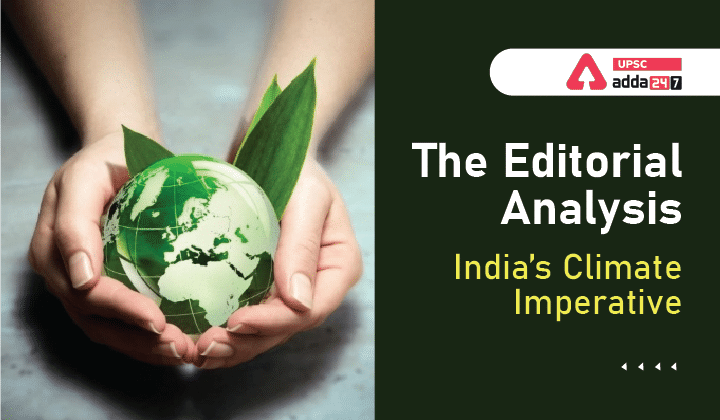Table of Contents
India’s Climate Imperative- Relevance for UPSC Exam
- GS Paper 3: Environment- Conservation, environmental pollution and degradation.
India’s Climate Imperative in News
- In the absence of COVID-19, climate change-induced disasters would have been India’s biggest red alert in recent years.
India’s Climate Vulnerability
- Rise in Temperature: Temperatures over the Indian Ocean have risen by over 1°C since the 1950s, increasing extreme weather events. Few examples of catastrophes are-
- The heatwave that scorched Rajasthan, Uttar Pradesh, Gujarat, and New Delhi this year;
- Torrential downpours in south India in 2021; and
- The super cyclone Amphan that battered West Bengal and Odisha in 2020.
- Climate Migration: India is the fourth worst-hit in climate migration. Heat waves in India have claimed an estimated 17,000 lives since the 1970s.
- Impact: Labour losses from rising heat, by one estimate, could reach ₹1.6 lakh crore annually if global warming exceeds 2°C, with India among the hardest hit.
- Heat Waves: Heatwaves are aggravated by deforestation and land degradation, which also exacerbate fires.
- Agriculture, being water-intensive, does not do well in heat wave-prone areas.
- Sea Level Rise: Floods and storms are worsened by vast sea ingress and coastline erosion in the low-lying areas in the south.
India’s Climate Imperative- Way Forward
- Resilience Against Weather Extremes: India needs to adapt to climate impacts by building resilience against weather extremes.
- Various Flood Resistant Measures:
- Kerala has some flood-resistant houses constructed on pillars.
- Communities can build round-shaped houses, considering optimum aerodynamic orientation to reduce the strength of the winds.
- Roofs with multiple slopes can stand well in strong winds, and central shafts reduce wind pressure on the roof by sucking in air from outside.
- Southern States need stronger guidelines to avoid construction in locations with drainages.
- It is vital to map flood-risk zones to manage vulnerable regions.
- Environment Impact Assessments must be mandatory for commercial projects.
- Mitigation Measures: India needs to work to mitigate environmental destruction to prevent climate change from becoming more lethal.
- Leading emitters, including India, must move away from fossil fuels.
- But climate mitigation everywhere is painfully slow, because of a lack of political will.
- India has made slow progress in choosing 2070 as its target for net zero emissions.
- Promote Sustainable Agriculture to counter Heat Waves: A solution is to promote agricultural practices which are not water-intensive and to support afforestation that has a salutary effect on warming.
- Financial transfers can be targeted to help farmers plant trees and buy equipment — for example, for drip irrigation that reduces heavy water usage.
- Insurance schemes can transfer some of the risks of extreme heat faced by industrial, construction and agricultural workers to insurers.
- Climate-resilient agriculture calls for diversification — for example, the cultivation of multiple crops on the same farm.
- There will need to be more localised food production. Weather-based crop insurance would help.
- Raising Climate Finance: India’s share in disaster management should be raised to 2.5% of GDP.
- Climate finance is most suited for large-scale global funding from the World Bank, the International Monetary Fund, and the Asian Development Bank.
- World Food Programme’s funding for Nepal and Bhutan for community-based adaptation and agricultural resilience for vulnerable communities provides an interesting model.
State Energy and Climate Index (SECI) 2022
https://www.adda247.com/upsc-exam/state-energy-and-climate-index-seci-2022/




 TSPSC Group 1 Question Paper 2024, Downl...
TSPSC Group 1 Question Paper 2024, Downl...
 TSPSC Group 1 Answer key 2024 Out, Downl...
TSPSC Group 1 Answer key 2024 Out, Downl...
 UPSC Prelims 2024 Question Paper, Downlo...
UPSC Prelims 2024 Question Paper, Downlo...




